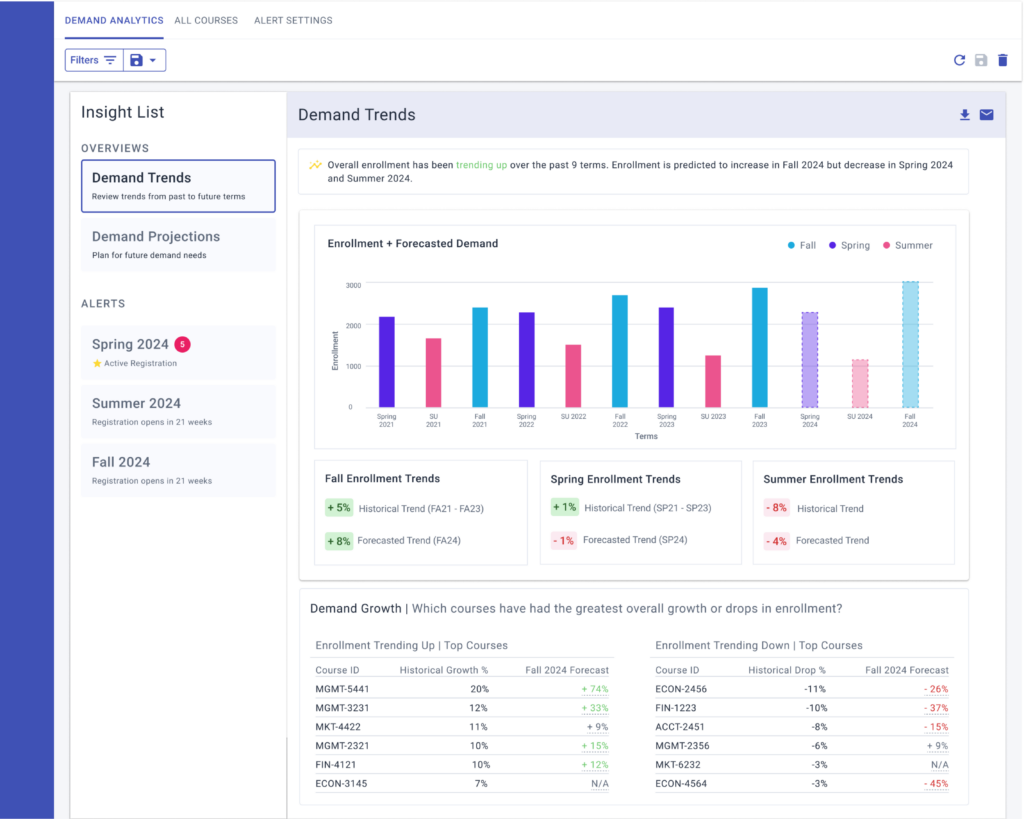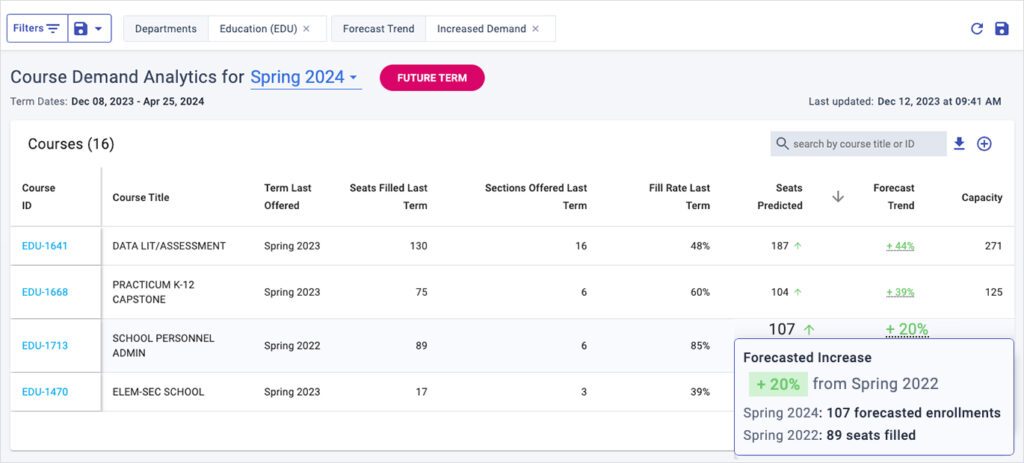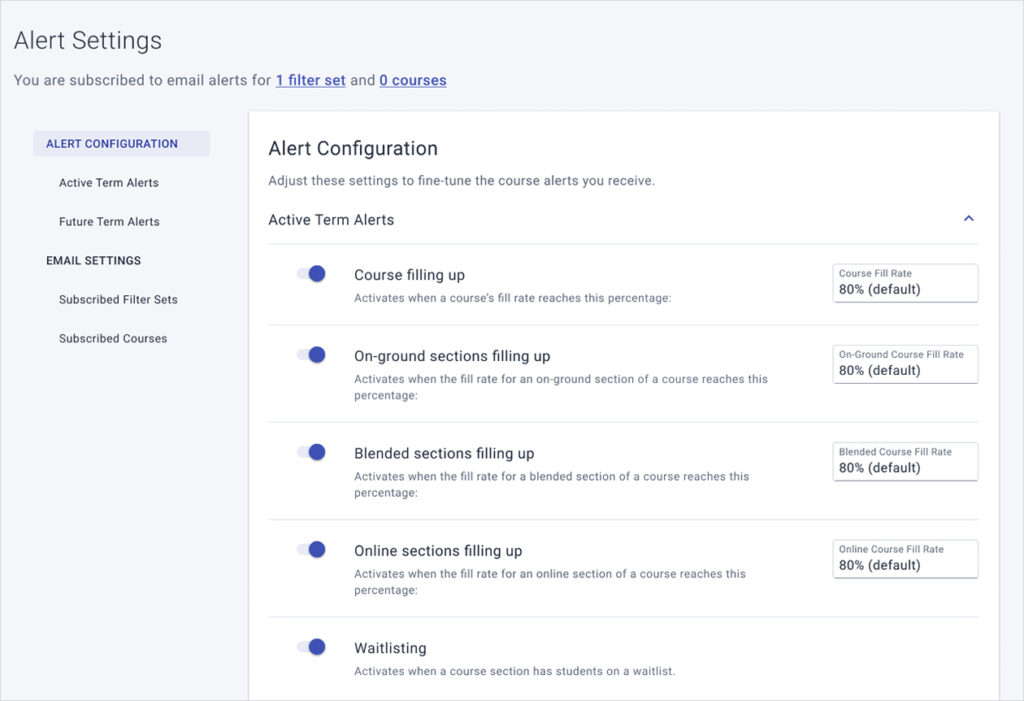
3 Ways to Optimize Your Course Schedule with Actionable Analytics
Share this Post
Higher education leaders strive to create a course schedule that is both efficient to build and easy for students to enroll in necessary courses. Despite this intention, course schedule planning is often a reactive process that can lead to increased workloads for staff and frustration for students during active registration periods.
Scenarios like the one described below can often unfold:
- Department chairs, academic deans, and registrars work within their independent silos, managing a cumbersome process that draws information from various sources, often lacking real-time inputs (i.e., feedback from advising, academic plans, transcripts, program demand, and more.)
- Registrars and advisors face an overwhelming workload during the active registration period, dealing with tasks like managing course capacities, waitlists and negotiating to add additional sections, particularly for high-demand times, modalities, or courses.
- Students face a frustrating registration experience, encountering courses that conflict with one another or don’t fit their scheduling needs, unavailable preferred modalities, and, most importantly, struggling to find the courses they need to graduate on time and within budget.
Relying on a ‘best guess’ scheduling approach can influence delays and barriers to graduation, impacting institutions with challenges like low student persistence and inefficient resource utilization.
This cycle often originates from three common barriers:
- Manually collecting course information from across campus
Pulling information from disparate systems across campus is time-consuming and leaves room for error when data and systems are not integrated. Most institutions build their course schedule by rolling over last year’s schedule and collecting faculty preferences. Factors such as student preferences, degree planning needs, and academic performance are rarely factored in, often leading to inefficient use of classroom space and faculty time, among other resources.
From a student’s view, these silos pose frustration when it comes to finding courses they need at the time they need to take them. For instance, if the history and math departments don’t communicate, students will likely encounter conflicts at a macro-cross departmental level if both classes only offer overlapping sections. This may result in students under-enrolling in course credits, taking classes they don’t need, and delaying graduation to a future term.
- Neglecting to think beyond the current term
During the active enrollment period, institutions often face difficulties in adding additional sections when courses fill up and making other necessary adjustments. This is due to limitations on classroom size, either because of classroom capacities or faculty contracts capping the number of students in a room. In addition, finding qualified faculty to teach a course, particularly in departments with a limited pool of highly qualified individuals, requires planning several months in advance.
This issue is often linked to students’ preferences for a specific modality (online vs. in-person or hybrid) not being accommodated. Student needs can vary due to factors such as grades from the previous term or program adjustments based on degrees that are in high or low demand. The ability to predict some of these barriers has the potential to dramatically affect enrollment and graduation rates.
- Misallocating institutional resources
Whether a classroom is crowded or underfilled typically stems from a misalignment between student needs and the institution’s ability to fulfill them. In one year, there may be a huge demand for business courses, and in other years, science and engineering may rise to the top due to job market demand or student interest. When institutions consider this information, along with important information like enrollment data from prior terms, they can more effectively plan ahead. They know what classrooms can fit high-demand courses, saving the smaller spaces for lower enrolling ones or courses that require a low faculty:student ratio.
Additionally, balancing faculty resources in course scheduling is crucial to optimizing academic operations. On one side, dedicating time and space to low-enrolling sections underutilizes faculty resources. On the other, finding faculty to teach additional sections can be challenging and often requires allocating a budget for salaries and time spent recruiting and interviewing candidates.
Data-Informed Course Schedule Planning
The good news is that it is now possible to address these barriers and take the guesswork out of building your course schedule. With Civitas Learning’s Course Demand Analytics solution, your team can balance student needs with institutional resources and avoid estimating what courses, sections, and modalities students need to graduate. The following capabilities help make this happen:
Access Real-Time Course Data with a Centralized Dashboard

Connecting course information from different programs across campus in one user-friendly platform provides a centralized, consistent source of truth. Administrators save valuable time not having to track down information from various departments and can easily understand potential scheduling issues that could delay student registration. This opens up lines of communication that were previously limited or handled through emails with little context. Administrators are notified automatically as courses fill or accrue waitlists with configurable alerts so you can adjust as soon as possible.
Administrators can also view particular sections that need attention through course-level insights. Users can filter and track which sections are filling fastest — identifying which modalities, days, and times are most popular and see where to adjust section capacities.
Accurately Predict Course Demand with AI-Based Forecasting

Course Demand Analytics empowers deans and administrators to see both short and long-term demand to plan ahead for future terms. They can avoid the time-consuming task of adding and removing sections and zero in on specific courses. The solution provides AI-based forecasts for up to a year in advance, and users can compare forecasted and historical demand to identify which courses will most likely need fewer or more seats to support student progress and completion.
Long-term, institutions can understand:
- Shifts in demand over time
- Accuracy of seats being offered
- Characteristics of students who typically take a course and their preferred modality
- Number of students planning to enroll in future terms
This visibility streamlines the tedious process of course schedule planning, saving hours of time spent on compiling reports and clarifying which course adjustments need to happen first rather than responding to requests as they come in.
Optimize Operational Overhead and Resources with Actionable Insights

Tracking enrollment and proactively resolving issues can minimize the financial impact on both students and institutions. Optimizing course offerings can save students time and money by preventing them from enrolling in additional terms unnecessarily. An optimized course schedule allows leaders to be responsible and prevent revenue loss due to student attrition. Real-time notifications are sent to administrators as courses fill up or have waitlists so they can make necessary adjustments before students make decisions on their enrollment. This also allows them to plan ahead for additional hiring and space demands.
Since program budgets are often allocated nearly a year before registration, having predictive data points to accurately forecast future course demand is a game-changer when it comes to justifying additional funding for faculty resources and additional hiring. The ability to intentionally allocate resources ensures institutions deliver an educational experience that meets accrediting body oversight and exceeds students’ expectations — aiding with recruitment for future classes.
Why Do Course Demand Insights Matter?
Navigating the course planning process shouldn’t have to be an impossible puzzle to solve, leading to graduation delays as students struggle to access the necessary courses for completion. With Course Demand Analytics, institutions can take control of a seemingly overwhelming process with a data-informed approach to course planning. They can plan for future terms and understand the resources needed to get there.
Learn more about Civitas Learning’s Course Demand Analytics solution.



